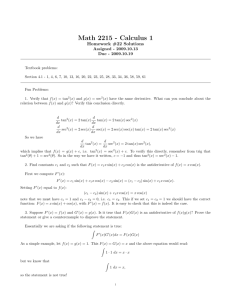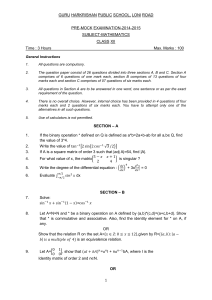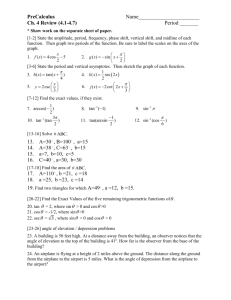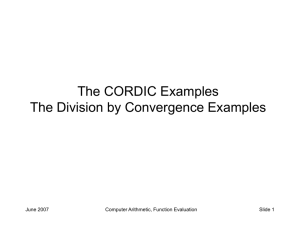Homework 2 1 Goldstein 1.22
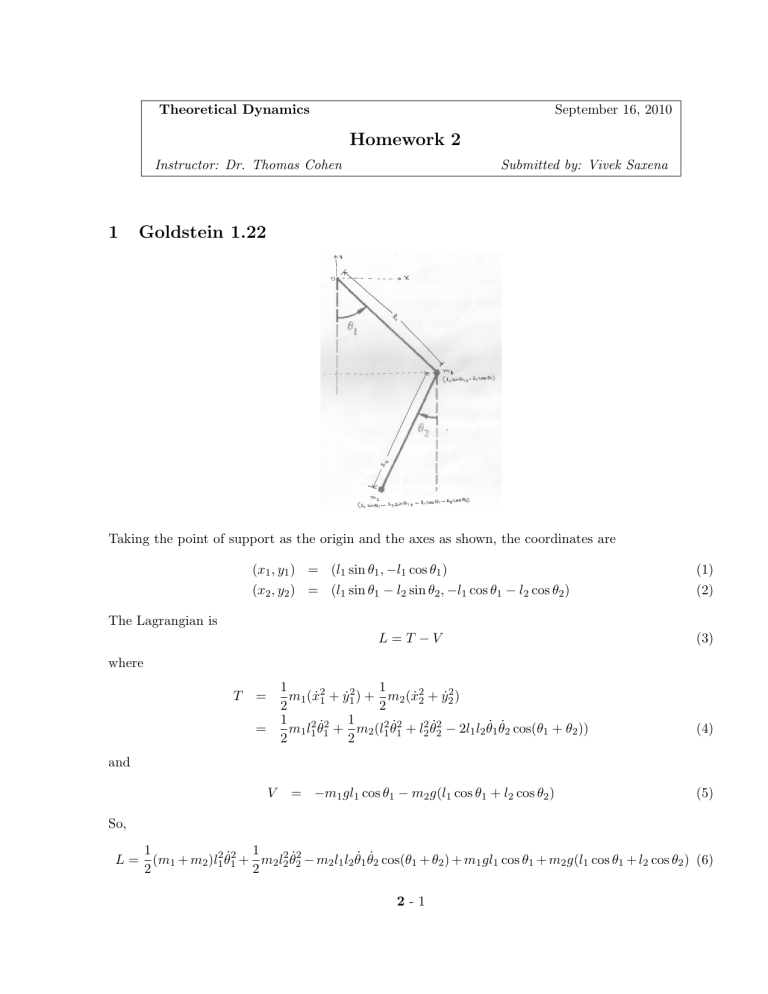
Theoretical Dynamics
Instructor: Dr. Thomas Cohen
Homework 2
September 16, 2010
Submitted by: Vivek Saxena
1 Goldstein 1.22
Taking the point of support as the origin and the axes as shown, the coordinates are
( x
1
, y
1
) = ( l
1 sin θ
1
, − l
1 cos θ
1
)
( x
2
, y
2
) = ( l
1 sin θ
1
− l
2 sin θ
2
, − l
1 cos θ
1
− l
2 cos θ
2
)
(1)
(2)
The Lagrangian is
L = T − V (3) where
T =
=
2
1
1 m
1
2 m
1
2
1 l
2
1
θ
˙ 2
1
+
2
1
) +
1
2 m
2
1
2 m
2
( l
2
1
θ
˙ 2
1
2
2
+ l
2
2
θ
˙ 2
2
2
2
)
− 2 l
1 l
2
θ
˙
1
θ
˙
2 cos( θ
1
+ θ
2
)) (4) and
V = − m
1 gl
1 cos θ
1
− m
2 g ( l
1 cos θ
1
+ l
2 cos θ
2
) (5)
So,
L =
1
2
( m
1
+ m
2
) l
2
1
θ
˙ 2
1
+
1
2 m
2 l
2
2
θ
˙ 2
2
− m
2 l
1 l
2
θ
˙
1
θ
˙
2 cos( θ
1
+ θ
2
) + m
1 gl
1 cos θ
1
+ m
2 g ( l
1 cos θ
1
+ l
2 cos θ
2
) (6)
2 - 1
The derivatives are
∂L
∂ θ
˙
1
= ( m
1
+ m
2
) l
2
1
θ
˙
1
− m
2 l
1 l
2
θ
˙
2 cos( θ
1
+ θ
2
) ,
∂L
∂ θ
˙
2
= m
2 l
2
2
θ
˙
2
− m
2 l
1 l
2
θ
˙
1 cos( θ
1
+ θ
2
) (7)
∂L
∂θ
1
= m
2 l
1 l
2
θ
˙
1
θ
˙
2 sin( θ
1
+ θ
2
) − m
1 gl
1 sin θ
1
− m
2 gl
1 sin θ
1
,
∂L
∂θ
2
= m
2 l
1 l
2
θ
˙
1
θ
˙
2 sin( θ
1
+ θ
2
) − m
2 gl
2 sin θ
2
(8) d dt
∂L
∂ θ
˙
1
= ( m
1
+ m
2
) l
2
1
¨
1
− m
2 l
1 l
2
¨
2 cos( θ
1
+ θ
2
) + m
2 l
1 l
2
θ
˙
2
( ˙
1
+ ˙
2
) sin( θ
1
+ d dt
∂L
∂ θ
˙
2
= m
2 l
2
2
θ
2
The Euler-Lagrange equations are
− m
2 l
1 l
2
θ
1 cos( θ
1
+ θ
2
) + m
2 l
1 l
2
θ
˙
1
θ
1
θ
2
) sin( θ
1
+ θ
2
)
θ
2
) (9)
(10) d dt d dt
∂L
∂ θ
˙
1
∂L
∂ θ
˙
2
−
−
∂L
∂θ
1
∂L
∂θ
2
=
=
0
0 that is,
( m
1
+ m
2
) l
2
1
θ
1
− m
2 l
1 m
2 l
2
1
θ
2 l
2
θ
2 cos( θ
1
− m
2 l
1 l
2
θ
1
+ θ
2
) + m
2 l
1 l
2
θ
˙ 2
2 cos( θ
1
+ θ
2
) + m sin(
2 l
1
θ
1
+ l
2
θ
˙ 2
1
θ
2 sin(
) + ( m
1
θ
1
+ θ
2
+ m
2
) + m
2
) gl
1 gl
2 sin θ
1 sin θ
2
= 0 (11)
= 0 (12)
2 Goldstein 2.20
Kinetic Energy
Potential Energy
T =
1
2
M ˙
2
1
V = mgy
2
+
1
2 m ( ˙
2
2
2
2
)
2 - 2
(13)
(14)
Constraint:
G ( x
1
, x
2
, y
2
) = y
2
− ( x
2
− x
1
) tan α = 0
Lagrangian:
L = T − V =
1
2
M ˙
2
1
+
1
2 m ( ˙
2
2
Constrained Lagrangian:
L c
= T − V − λG =
1
2
M ˙
2
1
+
1
2 m ( ˙
2
2
The Euler-Lagrange equation,
2
2
) − mgy
2
2
2
) − mgy
2
− λ [ y
2
− ( x
2
− x
1
) tan α ] d dt d dt d dt
∂L
∂ ˙
1
∂L
∂ ˙
2
∂L
∂ y ˙
2
∂L
−
∂x
1
∂L
−
∂x
2
∂L
−
∂y
2
=
=
=
0
0
0 give
(15)
(16)
(17)
(18)
(19)
(20)
M ¨
1
+ λ tan α = 0 m ¨
2
− λ tan α = 0 m ¨
2
+ mg + λ = 0
(21)
(22)
(23)
Adding (21) and (22) we get
M ¨
1
+ m ¨
2
= 0 (24) which upon one integration wrt time, yields the expected result that the l inear momentum of the
(block + wedge) system in the X -direction is constant . Multiplying (23) throughout by tan α , using (15) to write ¨
2
= (¨
2
− ¨
1
) tan α and substituing λ tan α = − M x
1 from (21) we get m (¨
2
− x
1
) tan α + mg + λ = 0
= ⇒ − ( M + m )¨
1 tan
2
α + mg tan α − M ¨
1
= 0
So,
¨
¨ y
1
2
2
=
= m
M
−
1 + m
M tan g tan α
2 α + 1
1 + m
M g tan α tan 2 α + 1
= − 1 + m
M 1 + g tan
2
α m
M mg tan 2 α + 1
λ = −
1 + m
M tan 2 α + 1
(25)
(26)
(27)
(28)
The signs are consistent: as the particle descends the slope of the wedge, it moves to the left in the ‘lab’ frame, as the wedge moves to the right, conserving linear momentum in the horizontal direction. Also, as m/M → 0, we recover the solution for a particle moving down a stationary wedge: x
1 p
¨ x
2
2
2 y
2
2
=
= g
− g sin sin
α ).
α cos α , ¨
2
= − g sin
2
α (so that the acceleration of the particle along the incline is
2 - 3
Work done by the constraint forces
The three ‘constraint forces’ are
F
F
F x
1 x y
2
2
∂G
= λ
∂x
1
∂G
= λ
∂x
2
= λ
∂G
∂y
2
=
=
=
λ
−
λ tan
λ
= tan
−
α =
α
−
=
1 + m
M mg tan α
1 + m
M tan
2 mg tan α
α + 1
1 + mg m
M tan 2 α + 1 tan 2 α + 1
(29)
(30)
(31)
The accelerations found above are constant, so the velocity varies linearly with time. Assuming that at t = 0, the wedge and particle both have zero velocity, the work done by the constraint force on the wedge is
W
1
=
Z
F x
1 dx
1
=
=
=
1
2
F x
1
1
−
2
¨
1 t
2
1 + mg tan α m
M tan
2
α + 1
! m
M
−
1
2
1 + m
2
M g 2 m
M tan 2 α tan
2
α + 1
2 t
2
1 + g tan α m
M tan
2
α + 1
!
t
2
Similarly, the work done by the constraint force on the particle is
(32)
(33)
W
2
=
Z
F x
2 dx
2
+
Z
F y
2 dy
2
=
=
1
2
F x
2
1
¨
2 t
2
+
1
2
F y
2 mg tan α
¨
2 t
2
2
+
1
2
1 + m
M
−
1 + tan m
M
2
α + 1
!
−
1 + g tan α m
M tan
2
α + 1
!
t
2 mg tan
2
α + 1
! m
− 1 +
M 1 + g tan
2
α m
M tan
2
α + 1
!
t
2
= −
1
=
1
2
2 mg
1 + m
M m
2
M g
2
1 + m
M
2 tan tan tan
2
2
2
α
α
α + 1 tan 2 α + 1
2
2 t
2 t
2
+
1
2 m 1 +
1 + m
M m
M g
2 tan
2 tan 2 α + 1
α
2 t
2
(34)
We note that W
1
+ W
2
= 0, confirming the fact that the total work done on the system by the constraint forces in time t is zero. This is consistent with the fact that the constraint forces are internal to the system, and the constraint G = 0 is independent of time.
2 - 4
3 Goldstein 13.4
The given Lagrangian density is
L = h
2
8 π 2 m
∇ ψ · ∇ ψ
∗
+ V ψ
∗
ψ + h
4 πi
( ψ
∗ ˙ − ψ ψ
∗
)
The Euler-Lagrange equation for ψ is
∂
µ
∂ L
∂ ( ∂
µ
ψ )
−
∂ L
∂ψ
= 0 that is, d dt
∂ L
∂
+ ∇ ·
∂ (
∂ L
∇ ψ )
−
∂ L
∂ψ
= 0
The derivatives are
∇ · d
Π =
∂ L
∂
∂ L dt ∂
∂ L
∂ ( ∇ ψ )
∂ L
∂ ( ∇ ψ )
∂ L
∂ψ
= h
4 πi
ψ
∗
=
=
= h
4 πi
ψ
∗ h
2
8 π 2 m
∇ ψ
∗ h
2
8 π 2 m
∇
2
ψ
∗
= V ψ
∗
− h
4 πi
ψ
∗
Substituting into (37), we get h
4 πi
ψ
∗
+ h
2
8 π 2 m
∇ 2
ψ
∗
− V ψ
∗
+ h
4 πi
ψ
∗
= 0 or ih dψ
2 π dt
= −
8 π h
2
2 m
∇
2
ψ + V ψ which is Schrodinger’s equation. The momentum canonically conjugate to ψ is
Π =
∂ L
∂
= h
4 πi
ψ
∗
So, the Hamiltonian density is
H = Π ˙ + Π
∗
ψ
˙ ∗
− L
= h
4 πi
ψ
∗ ˙
− h
4 πi
ψ
∗
ψ −
= −
8 π h 2
2 m
∇ ψ · ∇ ψ
∗
−
8
V ψ
π h
∗
2
2 m
ψ
∇ ψ · ∇ ψ
∗
− V ψ
∗
ψ − h
4 πi
ψ
∗ ˙
+ h
4 πi
ψ ψ
˙ ∗
2 - 5
(35)
(36)
(37)
(38)
(39)
(40)
(41)
(42)
4 Problem 1
The equations of motion are
¨ + ω
2 x = 0
¨ + αω
2 y = 0
Part a
The energy is
E =
1
2 m ( ˙
2 y
2
) +
1
2 mω
2
( x
2
+ αy
2
)
So, dE dt
= m ( ˙ ¨ + ˙ y ) + mω
2
( x ˙ + αy y ˙ )
= m ( ˙ ( − ω
2 x ) + ˙ ( − αω
2 y )) + mω
2
( x ˙ + αy y )
= 0
Hence the energy is conserved.
(using (43) and (44))
Part b d ∆ dt
= m ( ˙ ¨ − y ˙ y ) + mω
2
( x ˙ − αy y ˙ )
= m ( ˙ ( − ω
2 x ) − y ˙ ( − αω
2 y )) + mω
2
( x ˙ − αy y ˙ )
= 0
Hence ∆ is conserved.
(using (43) and (44))
(43)
(44)
(45)
(46)
(47)
Part c
It can be shown that for a holonomic mechanical system, the kinetic energy is always a bilinear form of the generalized coordinates, making terms of the form ∂L/∂ q ˙ necessarily linear in the generalized velocities, whenever the potential is independent of the (generalized) velocity. In particular, for the given Lagrangian,
∂L
∂ ˙
∂L
∂ y ˙
=
= m m y ˙
˙ (48)
(49)
Since Q
1
( x, y ; ) and Q
2
( x, y ; ) are point transformations, they are independent of velocities. Therefore the quantity
Γ =
∂L
∂ ˙
∂Q
1
∂
= m ˙
∂Q
1
∂
=0
+
∂L
∂ y ˙
∂Q
∂
=0
+ m y ˙
∂Q
2
∂
2
=0
=0
(50)
(51) necessarily linear in the velocities, ˙ y .
2 - 6
Part d
As justified above, any invariant quantity resulting from the symmetry of the Lagrangian under a point transformation is necessarily linear in the velocities. Since ∆ is a quadratic form in the velocities, we cannot find a point transformation which leaves the Lagrangian invariant and corresponds to a Noetherian conserved current that is equal to ∆. This proves that while every invariance of a Lagrangian under a continuous point transformation yields an associated conserved quantity, the converse is not necessarily true.
For holonomic mechanical systems, the stronger statement is: For every invariance of a Lagrangian under a continuous point transformation, there is an associated conserved quantity linear in the generalized momenta, and vice versa .
Part e
For α = 1, the system becomes an isotropic harmonic oscillator in 2D with the Lagrangian,
L =
1
2 m ( ˙
2 2
) −
1
2 mω
2
( x
2
+ y
2
)
Due to rotational symmetry, the angular momentum
(52)
J z
= m ( x y ˙ − xy ) (53) is an invariant, which is of the form Γ. As J z is linear in the velocities, it cannot be written as a linear combination of E and ∆ (which have no linear terms in ˙ y at all).
5 Problem 2
Part a
The action is
S =
Z dt L =
Z dt dx L (54)
The Lagragian density is not explicitly dependent on the field, but only on its derivatives. So, the variation in the action is
δS = δ
Z dt dx L (55)
=
Z dt dx δ L (56)
=
Z dt dx
∂ L
∂ ( ∂ t
φ )
δ ( ∂ t
φ ) +
∂ L
∂ ( ∂ x
φ )
δ ( ∂ x
φ )
=
=
Z
Z
= −
Z dt dx dt dx ∂
∂ L
∂ ( ∂
µ
φ )
δ ( ∂
µ
φ )
µ dt dx ∂
µ
∂ L
∂ ( ∂
µ
φ )
δφ − ∂
µ
∂ L
δφ
∂ ( ∂
µ
φ ) for µ = 0 , 1
∂ (
∂
∂
L
µ
φ )
δφ
(57)
(58)
(59)
(60)
2 - 7
since the first term in (60) can be converted to a surface integral over the boundary of the (1 +
1)-spacetime region, where δφ = 0 over the boundary. So, Hamilton’s principle δS = 0 yields the
Euler-Lagrange equation
∂ L
∂
µ
∂ ( ∂
µ
φ )
= 0 (61) or
∂
∂t
∂ L
+
∂ ( ∂ t
φ )
= ⇒ ( ∂
2 t
∂ ∂ L
= 0
∂x ∂ ( ∂ x
φ )
− c
2
∂
2 x
) φ ( x, t ) = 0
(62)
(63)
Part b
From the inverse Lorentz transformations, t = γ t
0
+
β c x
0 x = γ x
0
+ βct
0 we have
∂φ
∂t
∂φ
∂x
0
0
=
∂t
∂t 0
∂φ
∂t
+
∂x
∂t 0
∂φ
∂x
= γ
=
∂φ
∂t
∂t
∂x
0
+
∂φ
∂t
γβc
+
∂φ
∂x
∂x
∂x
0
∂φ
∂x
γβ ∂φ ∂φ
= + γ c ∂t ∂x
So, the Lagrangian density in the transformed frame is
L
0
=
=
1
2
1
"
2
"
∂φ
∂t 0
γ
2
2
− c
2
∂φ
∂t
2
∂φ
∂x 0
2
+ γ
2
β
2 c
2
#
∂φ
∂x
2
+ 2 γ
2
βc
∂φ
∂t
∂φ
!
∂x
=
=
− c
2
γ
2
β
2 c 2
1
"
γ
2
(1 − β
2
)
2
∂φ
∂t
∂φ
∂t
2
+ γ
2
2
∂φ
∂x
2
+
2 γ
2
β c
− γ
2 c
2
(1 − β
2
)
∂φ ∂φ
!#
∂t
∂φ
∂x
2
∂x
#
1
2
= L
"
∂φ
∂t
2
− c
2
∂φ
∂x
2 # as γ = √ 1
1 − β 2
Hence the Lagrangian density is invariant under the Lorentz transformation.
(64)
(65)
(66)
(67)
(68)
(69)
(70)
2 - 8
Part c dx dt =
∂x
∂x
0
∂t
∂x
0
∂x
∂t
0
∂t
∂t
0 dx
0 dt
0
=
γ γβc
γβ c
γ dx
= γ
2
(1 − β
2
) dx
0
0 dt
0 dt
0
= dx
0 dt
0
(71)
(72)
So the volume element in (1 + 1)-spacetime is Lorentz invariant. Since the Lagrangian density is also
R
Lorentz invariant, therefore the action S = dt dx L is also a Lorentz invariant quantity.
Part d
The Euler-Lagrange equation is obtained by extremizing the action, i.e. via δS = 0. As L , the (1 + 1)spacetime volume element as well as the Lagrangian density L are all Lorentz invariant quantities,
δS = δ
Z dt dx L = 0 ←→ δS
0
= δ
Z dt
0 dx
0
L
0
= 0 = δS (73)
Repeating the steps carried out in part (a) with all quantities replaced by their primed counterparts, we arrive at the Euler Lagrange equation,
∂
∂t 0
∂ L
∂ ( ∂ t
0
0
φ )
+
∂
∂x 0
∂ L
0
∂ ( ∂ x
φ )
= 0 (74) in the transformed frame. This proves that the Euler-Lagrange equations are form invariant, i.e. covariant.
In particular, using (67) and (68) we have
∂
2
φ
∂t 0 2
∂
2
φ
∂x 0 2
= γ
2
∂
2 t
φ + 2 γ
2
βc∂
2 xt
φ + γ
2
β
2 c
2
∂
2 x
=
γ
2
β
2 c 2
∂
2 t
φ +
2 γ
2
β c
∂
2 xt
φ + γ
2
β
2 c∂
2 x so that
∂
2
∂t
φ
0 2
− c
2
∂
2
φ
∂x
0 2
= γ
2
(1 − β
2
) ∂
2 t
φ − γ
2
(1 − β
2
) ∂
2 x
=
∂
2
φ
∂t 2
− c
2
∂
2
φ
∂x 2
So, we conclude that the Euler-Lagrange equation is also invariant.
(75)
(76)
(77)
(78)
2 - 9
6 Problem 3
The modified action is
S
0
Z t
2
= dt L
0 t
1
Z t
2
= dt
1
2 m ˙
2
− q φ
0
− d Λ
+ ( A + ∇ Λ) · ˙
=
Z t
1 t
2 dt L + q d Λ dt
− q ∇ Λ · ˙ dt t
1
Z t
2 d Λ Z t
2
= S + q dt − q dt ∇ Λ · ˙
= S + q
= S + q t
1 dt t
1
Z t
1 t
Z t
2
2 t = t
1 dt d Λ dt d Λ − q
Z
− q
Z t
2 t
1 t
2 d d Λ x · ∇ Λ t = t
1
= S
(79)
(80)
(81)
(82)
(83)
(84)
(85)
So, under a time dependent gauge transformation, the action is left invariant, independent of the path.
2 - 10





